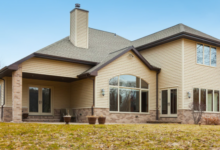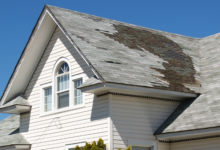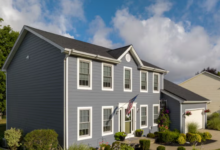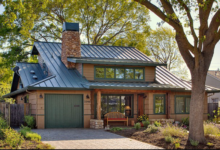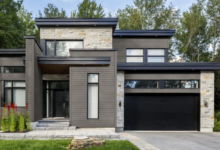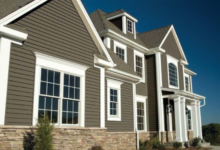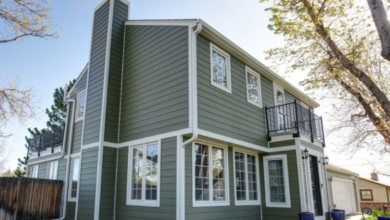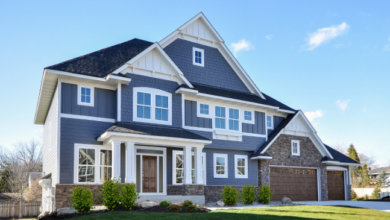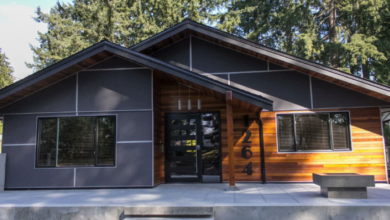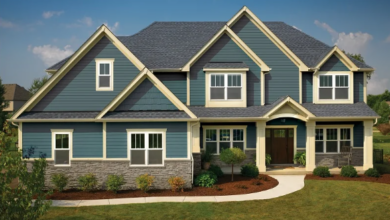Best Eco-Friendly House Siding Options for Sustainable Living
Best Eco-Friendly House Siding – Discover top eco-friendly house siding options that enhance your home’s sustainability and curb appeal. Learn about materials, benefits, and where to purchase.
Best Eco-Friendly House Siding Options for Sustainable Living
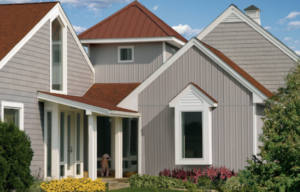
Choosing the right siding for your home is crucial not only for aesthetics and protection but also for environmental sustainability. Eco-friendly house siding options have become increasingly popular as homeowners seek to reduce their carbon footprint and promote a healthier planet. In this comprehensive guide, we’ll explore the best eco-friendly siding materials, their benefits, real-world product examples, and where to purchase them.
Why Choose Eco-Friendly Siding?
Choosing eco-friendly siding is a decision that benefits both your home and the environment. Here’s a breakdown of the key reasons why it’s a smart choice:
1. Reduced Environmental Impact:
- Sustainable Materials:
- Eco-friendly siding often utilizes materials that are sustainably sourced, recycled, or rapidly renewable.
- This reduces the demand for virgin resources and minimizes the environmental impact of manufacturing.
- Lower Carbon Footprint:
- Manufacturing and transporting certain siding materials can contribute to greenhouse gas emissions.
- Eco-friendly options, such as those made from recycled content or locally sourced materials, can help reduce your carbon footprint.
- Reduced Waste:
- Some eco-friendly siding products are designed for durability and longevity, reducing the need for frequent replacements and minimizing waste.
- Recycled materials also reduce the waste in landfills.
2. Improved Energy Efficiency:
- Insulation:
- Many eco-friendly siding options, like those made from insulated materials or designed for use with external insulation systems, can improve your home’s energy efficiency.
- This leads to reduced heating and cooling costs, as well as a smaller environmental impact.
- Reflective Properties:
- Certain eco-friendly metal siding options can reflect sunlight, reducing heat absorption and keeping your home cooler in warm weather.
3. Healthier Indoor Environment:
- Low VOC Emissions:
- Some traditional siding materials can release volatile organic compounds (VOCs) that can negatively impact indoor air quality.
- Eco-friendly siding options often have low or no VOC emissions, creating a healthier indoor environment.
- Mold and Mildew Resistance:
- Many eco-friendly siding materials are designed to resist moisture, preventing mold and mildew growth.
4. Increased Home Value:
- Sustainable Features:
- Eco-friendly features are becoming increasingly desirable to homebuyers.
- Installing eco-friendly siding can enhance your home’s curb appeal and increase its resale value.
- Modern Appeal:
- Many eco-friendly siding options have a very modern and desirable look.
5. Durability and Longevity:
- Long-Lasting Materials:
- Eco-friendly siding materials are often designed for durability and longevity, reducing the need for frequent replacements.
- This translates to long-term cost savings and a reduced environmental impact.
- Weather Resistance:
- Many eco-friendly options are designed to withstand harsh weather.
6. Responsible Sourcing:
- Forest Stewardship Council (FSC) Certification:
- For wood siding, look for FSC certification, which ensures that the wood is sourced from responsibly managed forests.
- Recycled Content:
- Choose siding materials made from recycled content to reduce the demand for virgin resources.
In essence, choosing eco-friendly siding is a responsible and sustainable decision that benefits both your home and the environment.
Top Eco-Friendly Siding Materials
Here are some of the most sustainable siding materials available:
1. Fiber Cement Siding
Fiber cement siding is made from a blend of cement, sand, and cellulose fibers. It’s known for its durability and minimal environmental impact.
Benefits:
- Fire and Pest Resistant: Non-combustible and resistant to termites.
- Low Maintenance: Requires minimal upkeep compared to wood siding.
- Versatility: Available in various textures and colors.
Product Example:
- James Hardie Fiber Cement Siding: Renowned for its durability and range of styles.
2. Reclaimed Wood Siding
Using reclaimed wood gives new life to old materials, reducing the demand for new lumber and preserving natural resources.
Benefits:
- Unique Appearance: Each piece has distinct character and history.
- Sustainability: Repurposes existing materials, minimizing environmental impact.
Product Example:
- Elmwood Reclaimed Timber: Offers a variety of reclaimed wood siding options.
3. Metal Siding
Often made from recycled materials, metal siding is durable and recyclable at the end of its lifespan.
Benefits:
- Longevity: Resistant to fire, pests, and rot.
- Energy Efficiency: Reflects sunlight, reducing cooling costs.
- Low Maintenance: Requires minimal upkeep.
Product Example:
- Bridger Steel Metal Siding: Provides sustainable metal siding solutions.
4. Brick and Stone Veneer
Natural stone and brick veneers are long-lasting and have a timeless appearance.
Benefits:
- Durability: Can last for decades with minimal maintenance.
- Thermal Mass: Helps regulate indoor temperatures.
- Natural Materials: Minimal processing reduces environmental impact.
Product Example:
- Eldorado Stone Veneer: Offers a range of stone veneer options.
5. Engineered Wood Siding
Engineered wood is manufactured using wood fibers and resins, offering the appearance of natural wood with enhanced performance.
Benefits:
- Cost-Effective: Less expensive than natural wood.
- Durability: Resistant to moisture and pests.
- Aesthetic Appeal: Mimics the look of real wood.
Product Example:
- LP SmartSide Siding: Known for its durability and realistic wood appearance.
Comparison of Eco-Friendly Siding Options
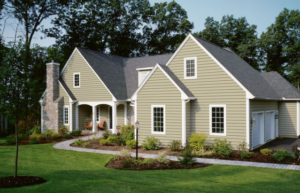
| Material | Pros | Cons | Price Range (per sq ft) | Features |
|---|---|---|---|---|
| Fiber Cement Siding | Durable, fire-resistant, low maintenance | Heavier material, requires skilled installation | $5 – $10 | Variety of textures and colors, pest-resistant |
| Reclaimed Wood Siding | Unique appearance, sustainable | May require more maintenance, availability varies | $7 – $15 | Distinct character, environmentally friendly |
| Metal Siding | Long-lasting, recyclable, low maintenance | Can dent, limited styles | $3 – $8 | Reflects sunlight, energy-efficient |
| Brick and Stone Veneer | Extremely durable, timeless aesthetic | Higher cost, professional installation needed | $10 – $20 | Natural thermal regulation, minimal maintenance |
| Engineered Wood Siding | Cost-effective, resembles real wood | Susceptible to moisture if not properly maintained | $4 – $9 | Variety of styles, enhanced durability |
Where to Buy Eco-Friendly Siding
Finding eco-friendly siding involves exploring various suppliers and manufacturers that prioritize sustainable practices. Here’s a guide on where to buy it:
1. Specialized Building Supply Stores:
- These stores often carry a wider range of eco-friendly building materials, including siding options made from recycled content, sustainably harvested wood, or other environmentally conscious materials.
- They often have knowledgeable staff who can provide information on the environmental impact of different products.
2. Lumberyards (Especially Those with FSC Certification):
- For wood siding, look for lumberyards that offer Forest Stewardship Council (FSC) certified products.
- FSC certification ensures that the wood comes from responsibly managed forests.
- Many lumberyards are also becoming more conscious of the environmentally friendly products that they carry.
3. Direct from Manufacturers:
- Some siding manufacturers specialize in eco-friendly products or offer sustainable options within their product lines.
- Contacting manufacturers directly can provide access to detailed information about their sourcing and production practices.
- Some manufacturers will also list local dealers on their websites.
4. Online Retailers:
- Online platforms offer a wide selection of eco-friendly siding products.
- Carefully review product descriptions and certifications to ensure that the siding meets your environmental standards.
- Be sure to check reviews, and shipping costs.
5. Reclaimed Building Material Stores:
- These stores specialize in selling salvaged or reclaimed building materials, including siding.
- This is a great option for those seeking unique or vintage siding with a low environmental impact.
6. Local Green Building Centers:
- Many communities have green building centers that provide resources and products for sustainable construction.
- These centers can be a valuable source of information and eco-friendly siding options.
Tips for Buying Eco-Friendly Siding:
- Look for Certifications:
- Check for certifications such as FSC, LEED, or Cradle to Cradle, which indicate that the siding meets environmental standards.
- Consider Recycled Content:
- Choose siding materials made from recycled content to reduce the demand for virgin resources.
- Prioritize Local Sourcing:
- Opt for siding materials that are sourced locally to minimize transportation emissions.
- Research Manufacturers’ Practices:
- Investigate the environmental practices of siding manufacturers to ensure they align with your values.
- Ask About VOC Emissions:
- Inquire about the volatile organic compound (VOC) emissions of the siding to ensure a healthy indoor environment.
- Think about the whole lifecycle:
- Consider the longevity of the product, and how easy it is to recycle at the end of its life.
By following these tips, you can find eco-friendly siding that meets your needs and contributes to a more sustainable future.
When purchasing, consider the following steps:
- Research Products: Identify which siding material best fits your environmental goals, aesthetic preferences, and budget.
- Find Suppliers: Locate local or online suppliers that offer the chosen material.
- Request Samples: Obtain samples to assess the material’s look and feel.
- Consult Professionals: Speak with contractors or installers to get quotes and assess installation requirements.
- Purchase and Schedule Installation: Once decided, place your order and schedule installation with qualified professionals.
Frequently Asked Questions
Q1: What makes siding eco-friendly?
Eco-friendly siding is made from sustainable, recyclable, or reclaimed materials and has a minimal environmental impact during production and installation.
Q2: Is fiber cement siding environmentally friendly?
Yes, fiber cement siding is considered eco-friendly due to its durability, longevity, and the use of sustainable materials in its production.
Q3: How does metal siding contribute to energy efficiency?
Metal siding reflects solar radiation, which can help reduce cooling costs in warmer climates.
Q4: Can I install eco-friendly siding myself?
Some siding materials, like engineered wood, are more DIY-friendly, while others, such as brick veneer, require professional installation.
Q5: How do I maintain eco-friendly siding?
Maintenance varies by material but generally includes regular cleaning and inspections. Some materials, like fiber cement and metal, require less upkeep than natural wood.
